Mitigating Range Ambiguity Method Based on DDMA for SAR Systems
Abstract
1. Introduction
2. Signal Model
3. A Mitigating Range Ambiguity Based on DDMA Waveform Method
4. Numerical Simulations
4.1. Differences of the Mitigating Range Ambiguity Method
4.2. Only One Center Point in Each Region
4.3. Design of the Passband Time Filter
4.4. Multiple Points in Each Region
5. Conclusions
Author Contributions
Funding
Conflicts of Interest
Appendix A. The Pre-Processed Operation for Different Channels
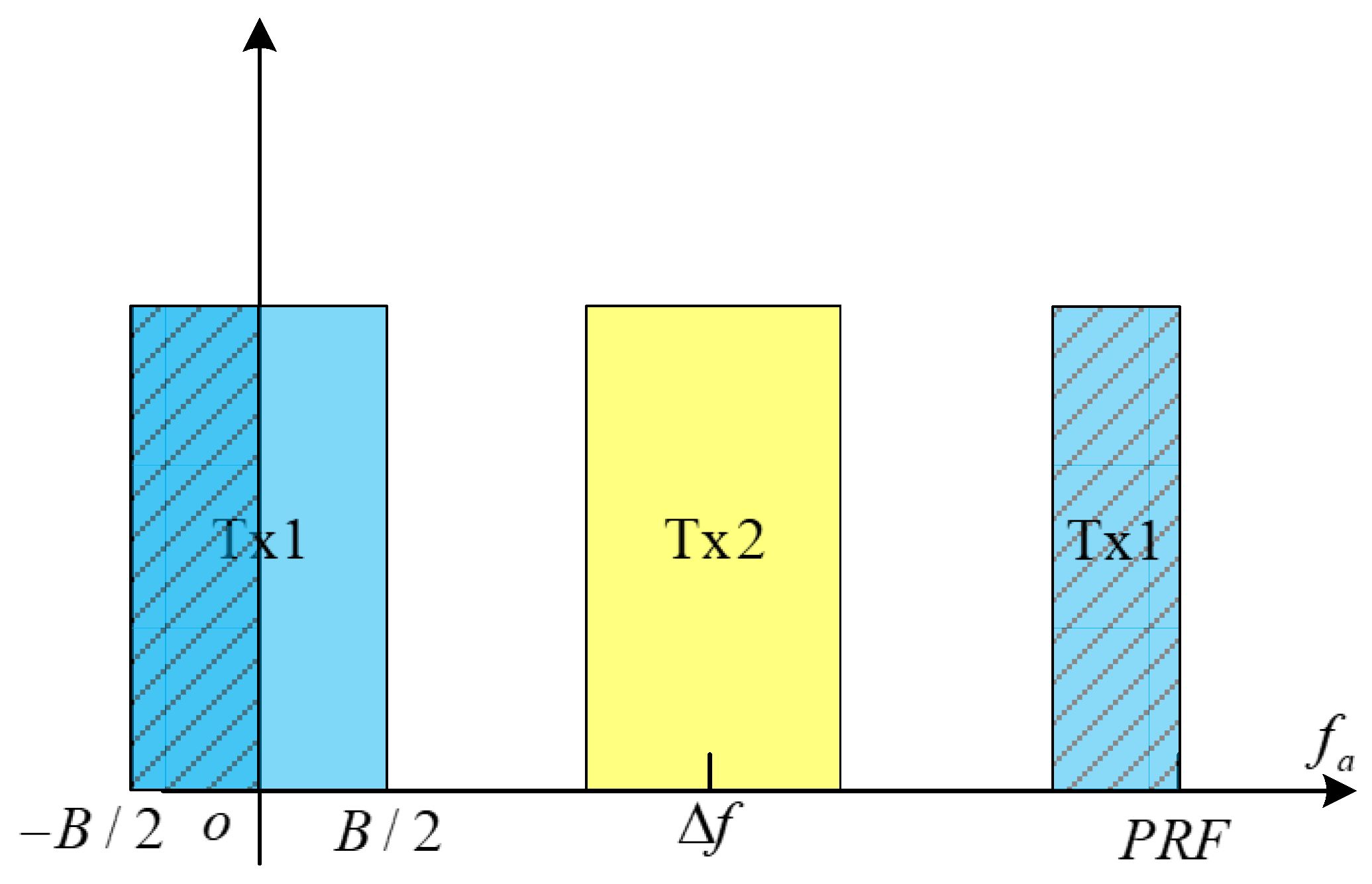
References
- Fan, H.; Zhang, L.; Zhang, Z.; Yu, W.; Deng, Y. On the processing of Gaofen-3 spaceborne dual-channel sliding spotlight SAR data. IEEE Trans. Geosci. Remote Sens. 2022, 60, 5202912. [Google Scholar] [CrossRef]
- Wang, Y.; Song, Q.; Wang, J.; Du, B.; Wang, P. A correction method to systematic phase drift of a high resolution radar for foreign object debris detection. Remote Sens. 2022, 14, 1787. [Google Scholar] [CrossRef]
- Djath, B.; Schulz-Stellenfleth, J.; Cañadillas, B. Study of coastal effects relevant for offshore wind energy using spaceborne synthetic aperture radar (SAR). Remote Sens. 2022, 14, 1688. [Google Scholar] [CrossRef]
- Chen, J.; Wang, K.; Yang, W.; Liu, W. Accurate reconstruction and suppression for azimuth ambiguities in spaceborne stripmap SAR images. IEEE Geosci. Remote Sens. Lett. 2017, 14, 102–106. [Google Scholar] [CrossRef]
- Zhao, B.; Zhang, Q. The staring mode properties and performance of geo-SAR satellite with reflector antenna. Remote Sens. 2022, 14, 1609. [Google Scholar] [CrossRef]
- Xiao, P.; Guo, W.; Wu, Y.; Liu, B. A comprehensive method of ambiguity suppression for constellation of geostationary and low earth orbit SAR. IEEE J. Sel. Top. Appl. Earth Obs. Remote Sens. 2020, 13, 3327–3335. [Google Scholar] [CrossRef]
- Zhang, S.; Xing, M.; Xia, X.; Zhang, L.; Guo, R.; Liao, Y.; Bao, Z. Multichannel HRWS SAR imaging based on range-variant channel calibration and multi-doppler-direction restriction ambiguity suppression. IEEE Trans. Geosci. Remote Sens. 2014, 52, 4306–4327. [Google Scholar] [CrossRef]
- He, F.; Dong, Z.; Zhang, Y.; Jin, G.; Yu, A. Processing of spaceborne squinted sliding spotlight and HRWS TOPS mode data using 2-D baseband azimuth scaling. IEEE Trans. Geosci. Remote Sens. 2020, 58, 938–955. [Google Scholar] [CrossRef]
- Raney, R.K.; Freeman, A.; Jordan, R.L. Improved range ambiguity performance in quad-pol SAR. IEEE Trans. Geosci. Remote Sens. 2012, 50, 349–356. [Google Scholar] [CrossRef]
- Anderson, J.M.; Temple, M.A.; Brown, W.M.; Crossley, B.L. A nonlinear suppression technique for range ambiguity resolution in pulse Doppler radars. In Proceedings of the 2001 IEEE Radar Conference (Cat. No.01CH37200), Atlanta, GA, USA, 3 May 2001. [Google Scholar]
- Mittermayer, J.; Martinez, J.M. Analysis of range ambiguity suppression in SAR by up and down chirp modulation for point and distributed targets. In Proceedings of the 2003 IEEE International Geoscience and Remote Sensing Symposium, Toulouse, France, 21–25 July 2013; pp. 1013–1015. [Google Scholar]
- Xiao, P.; Liu, M.; Guo, W.; Yu, J. The range ambiguity suppression based on amplitude modulation chirp. In Proceedings of the 2019 IEEE International Geoscience and Remote Sensing Symposium, Yokohama, Japan, 28 July–2 August 2019. [Google Scholar]
- Wang, H.; Zhang, Y.; Xu, J.; Liao, G.; Zhu, S. Range ambiguity suppression in a synthetic aperture radar using pulse phase coding and two-pulse cancellation. Int. J. Remote Sens. 2018, 39, 6525–6539. [Google Scholar] [CrossRef]
- Wang, H.; Zhang, Y.; Xu, J.; Liao, G.; Zeng, C. Study on coding scheme for space-pulse-phase-coding-based high-resolution and wide-swath SAR imaging. Int. J. Remote Sens. 2020, 41, 7186–7200. [Google Scholar] [CrossRef]
- Dall, J.; Kusk, A. Azimuth phase coding for range ambiguity suppression in SAR. In Proceedings of the 2004 IEEE International Geoscience and Remote Sensing Symposium, Anchorage, AK, USA, 20–24 September 2004. [Google Scholar]
- Zhang, Y.; Wang, W.; Deng, Y.; Yu, W.; Zhang, Z.; Zhao, P.; Wang, R. Quadratically constrained ambiguity suppression algorithm for APC/multichannel SAR systems with nonuniform spatial sampling. IEEE Trans. Geosci. Remote Sens. 2021, 59, 1319–1330. [Google Scholar] [CrossRef]
- Dai, C.; Wang, T.; Zhao, B. Concept of Geo-SAR system with dbf antenna and range ambiguity performance discussion. In Proceedings of the IET International Radar Conference (IET IRC 2020), Online Conference, 4–6 November 2020. [Google Scholar]
- Ryu, J.; Yi, D.; Kim, S.; Yoon, G. Suppression of range ambiguity in spaceborne SAR with elevation beam pattern mask design. IEEE Geosci. Remote Sens. Lett. 2021, 19, 4008605. [Google Scholar] [CrossRef]
- Villano, M.; Krieger, G.; Moreira, A. Staggered SAR: High-resolution wide-swath imaging by continuous PRI variation. IEEE Trans. Geosci. Remote Sens. 2014, 52, 4462–4479. [Google Scholar] [CrossRef]
- Riché, V.; Méric, S.; Baudais, J.; Pottier, É. Investigations on OFDM signal for range ambiguity suppression in SAR configuration. IEEE Trans. Geosci. Remote Sens. 2014, 52, 4194–4197. [Google Scholar] [CrossRef]
- Wang, W.Q.; Shao, H.Z.; Cai, J.Y. Range angle dependent beamforming by frequency diverse array antenna. Int. J. Antennas Propag. 2012, 2012, 760489. [Google Scholar] [CrossRef]
- Wang, C.; Xu, J.; Liao, G.; Xu, X.; Zhang, Y. A range ambiguity resolution approach for high-resolution and wide-swath SAR imaging using frequency diverse array. IEEE J. Sel. Top. Signal Process 2017, 11, 336–346. [Google Scholar] [CrossRef]
- Chen, Z.; Zhang, Z.; Zhou, Y.; Zhao, Q.; Wang, W. Elevated frequency diversity array: A novel approach to high resolution and wide swath imaging for synthetic aperture radar. IEEE Geosci. Remote Sens. Lett. 2020, 19, 1–5. [Google Scholar] [CrossRef]
- Blunt, S.D.; Mokole, E.L. Overview of radar waveform diversity. IEEE Aerosp. Electron. Syst. Mag. 2016, 31, 2–42. [Google Scholar] [CrossRef]
- Sun, H.; Brigui, F.; Lesturgie, M. Analysis and comparison of MIMO radar waveforms. In Proceedings of the 2014 International Radar Conference, Lille, France, 13–17 October 2014. [Google Scholar]
- Mecca, V.F.; Krolik, J.L.; Robey, F.C. Beamspace slow-time MIMO radar for multipath clutter mitigation. In Proceedings of the 2008 IEEE International Conference on Acoustics, Speech and Signal Processing, Las Vegas, NV, USA, 31 March 2008–4 April 2008. [Google Scholar]
- Rabideau, D.J. Doppler-offset waveforms for MIMO radar. In Proceedings of the IEEE Radar Conference, Kansas City, MO, USA, 23–27 May 2011; pp. 965–970. [Google Scholar]
- Rabideau, D.J. MIMO radar waveforms and cancellation ratio. IEEE Trans. Aerosp. Electron. Syst. 2012, 48, 1167–1178. [Google Scholar] [CrossRef]
- Li, F.; He, F.; Dong, Z.; Wu, M.; Zhang, Y.; Sun, Z. Blind velocities mitigation for ddma mimo gmti radar via multi-frequency signals. In Proceedings of the IEEE 2018 19th International Radar Symposium (IRS), Bonn, Germany, 20–22 June 2018; pp. 1–9. [Google Scholar]
- Rossum, W.V.; Anitori, L. Doppler ambiguity resolution using random slow-time code division multiple access MIMO Radar with sparse signal processing. In Proceedings of the 2018 IEEE Radar Conference (RadarConf18), Oklahoma City, OK, USA, 23–27 April 2018; pp. 1–5. [Google Scholar]
- Xu, F.; Vorobyov, S.A.; Yang, F. Transmit Beamspace DDMA based automotive MIMO radar. IEEE Trans. Veh. Techn. 2022, 71, 1669–1684. [Google Scholar] [CrossRef]
- Wang, W. Mitigating range ambiguities in high-PRF SAR with OFDM waveform diversity. IEEE Geosci. Remote Sens. Lett. 2013, 10, 101–105. [Google Scholar] [CrossRef]
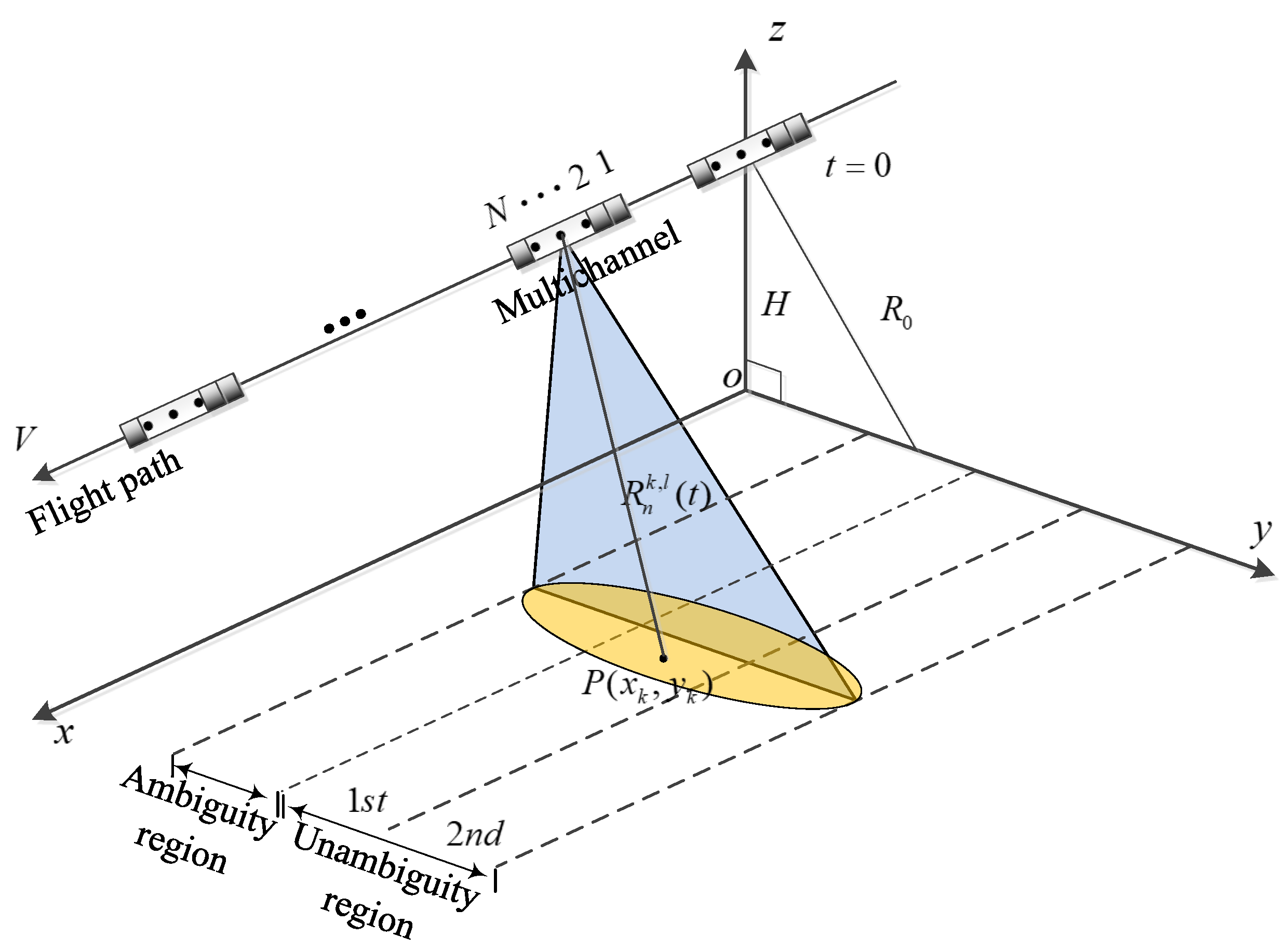
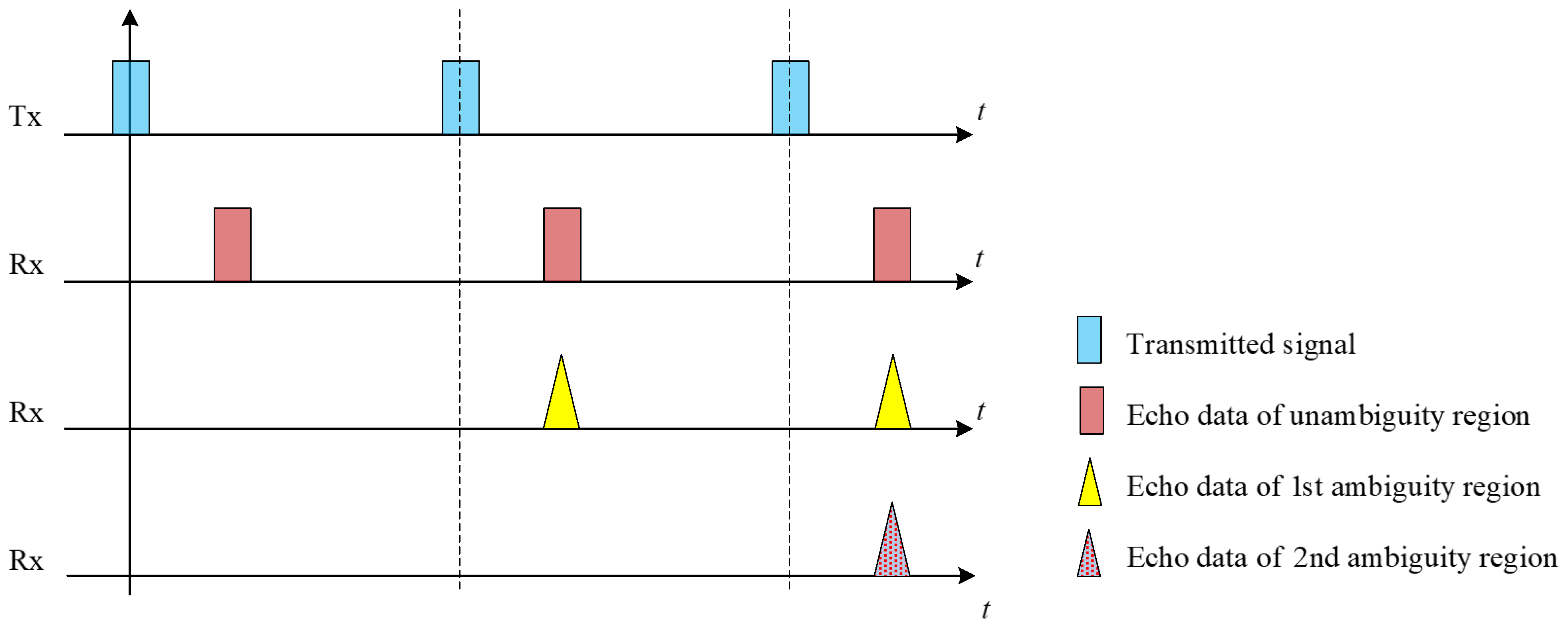
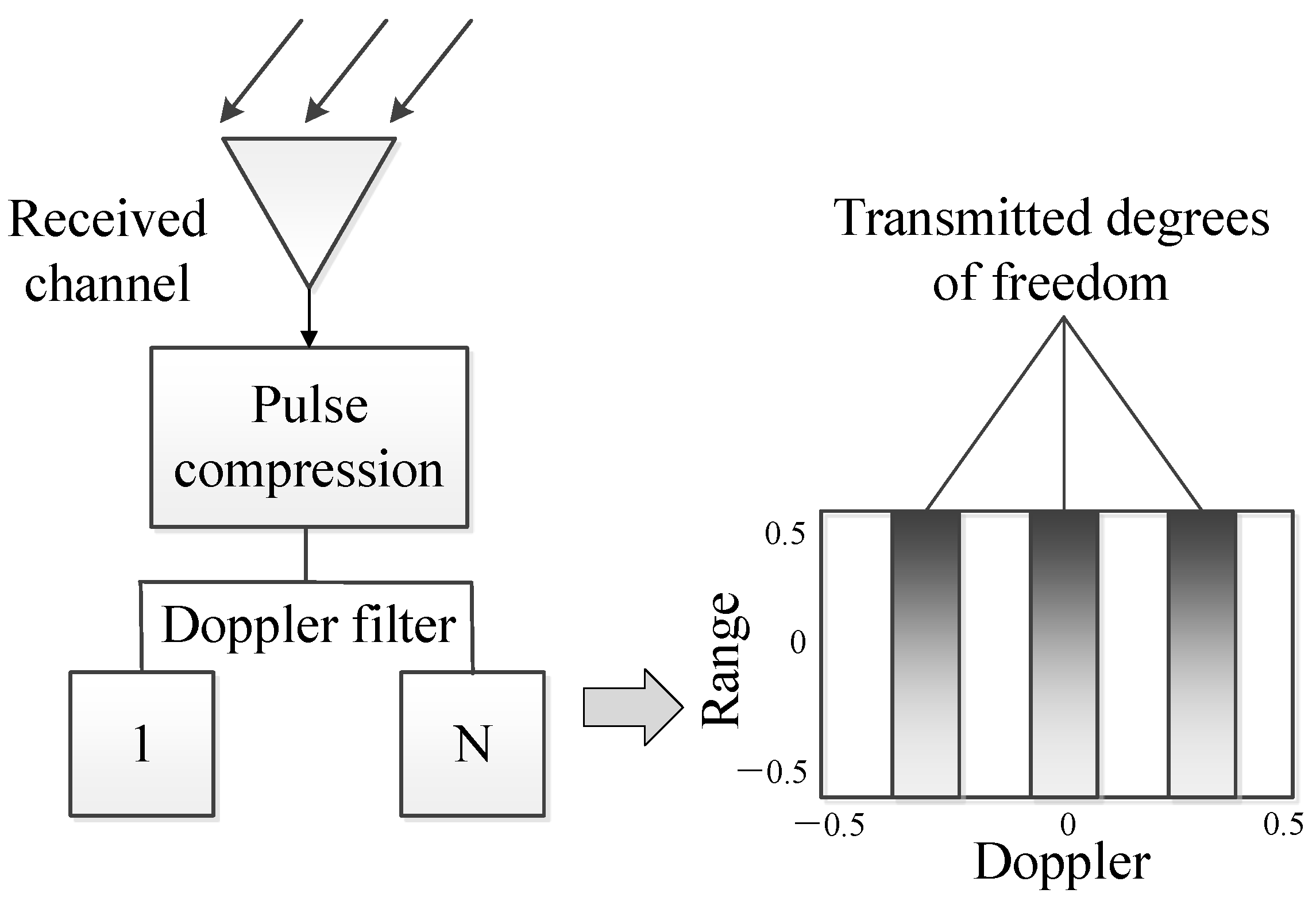
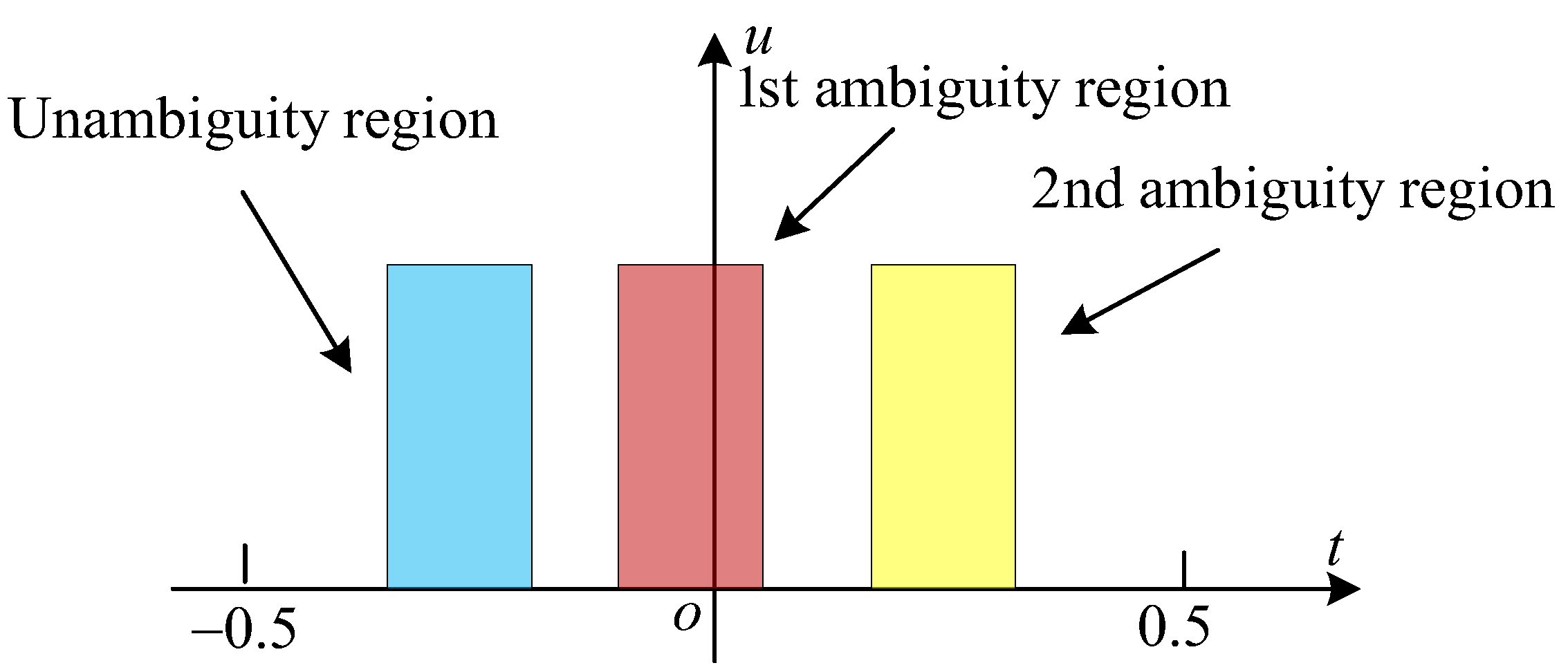

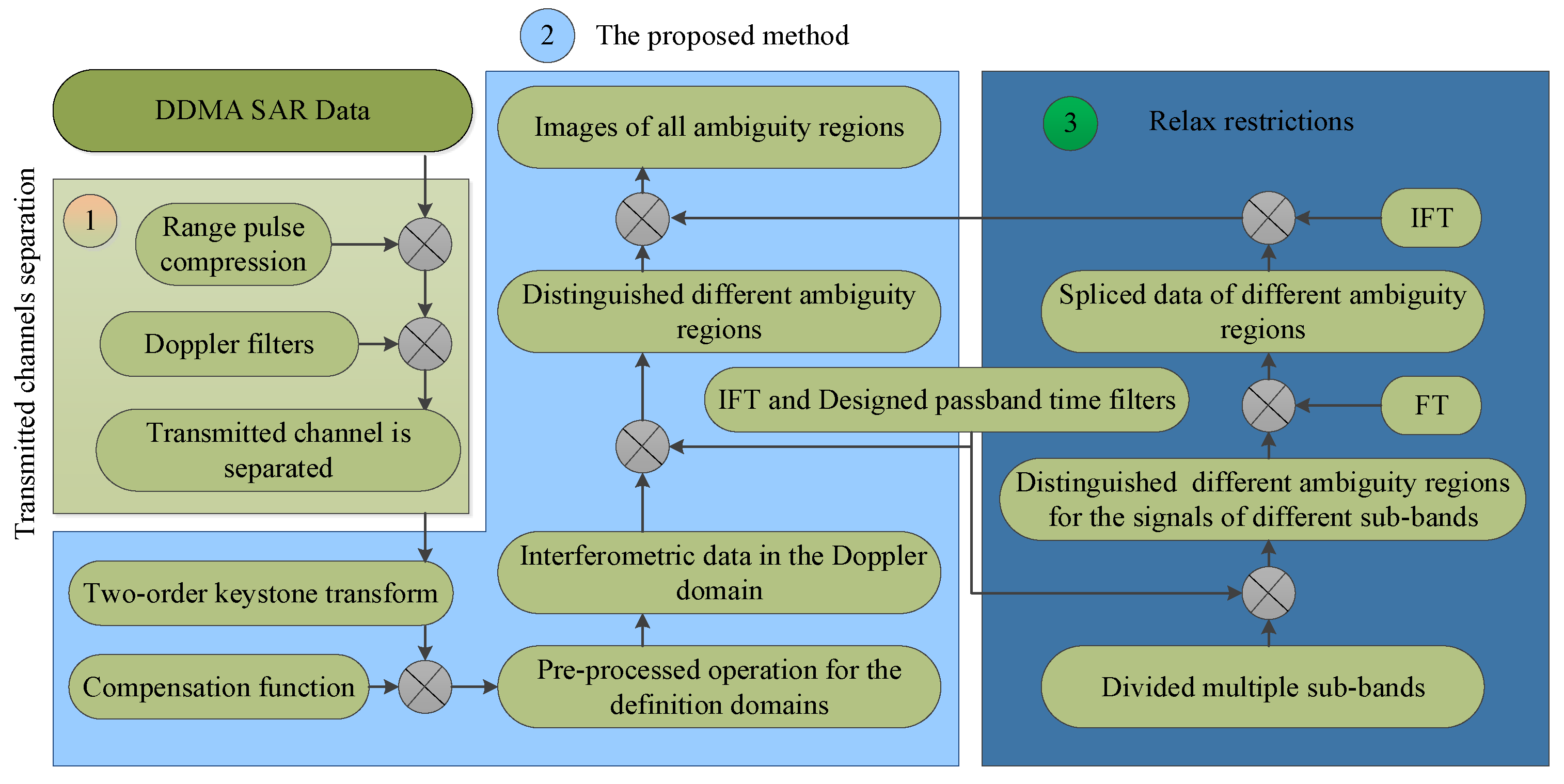
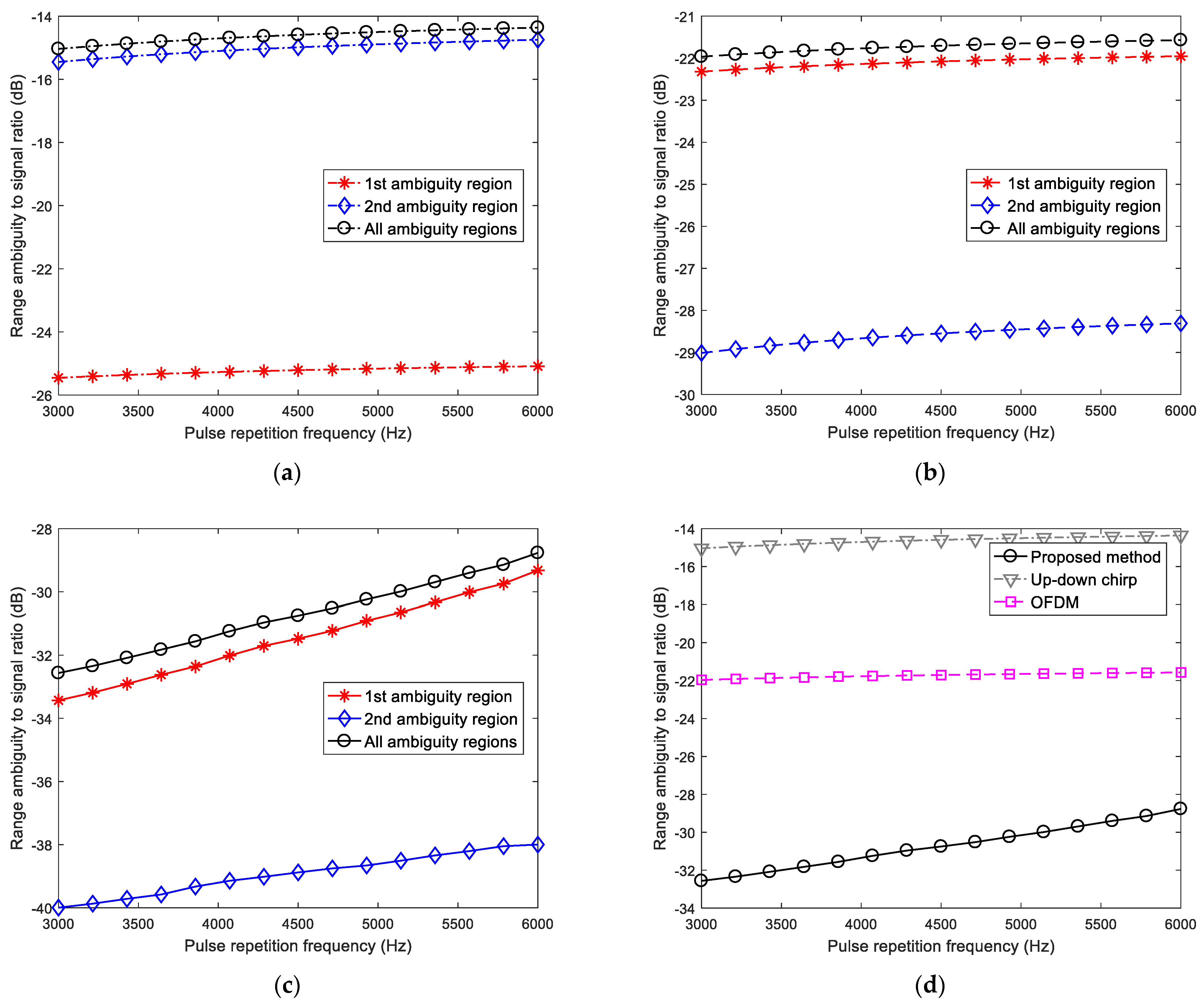
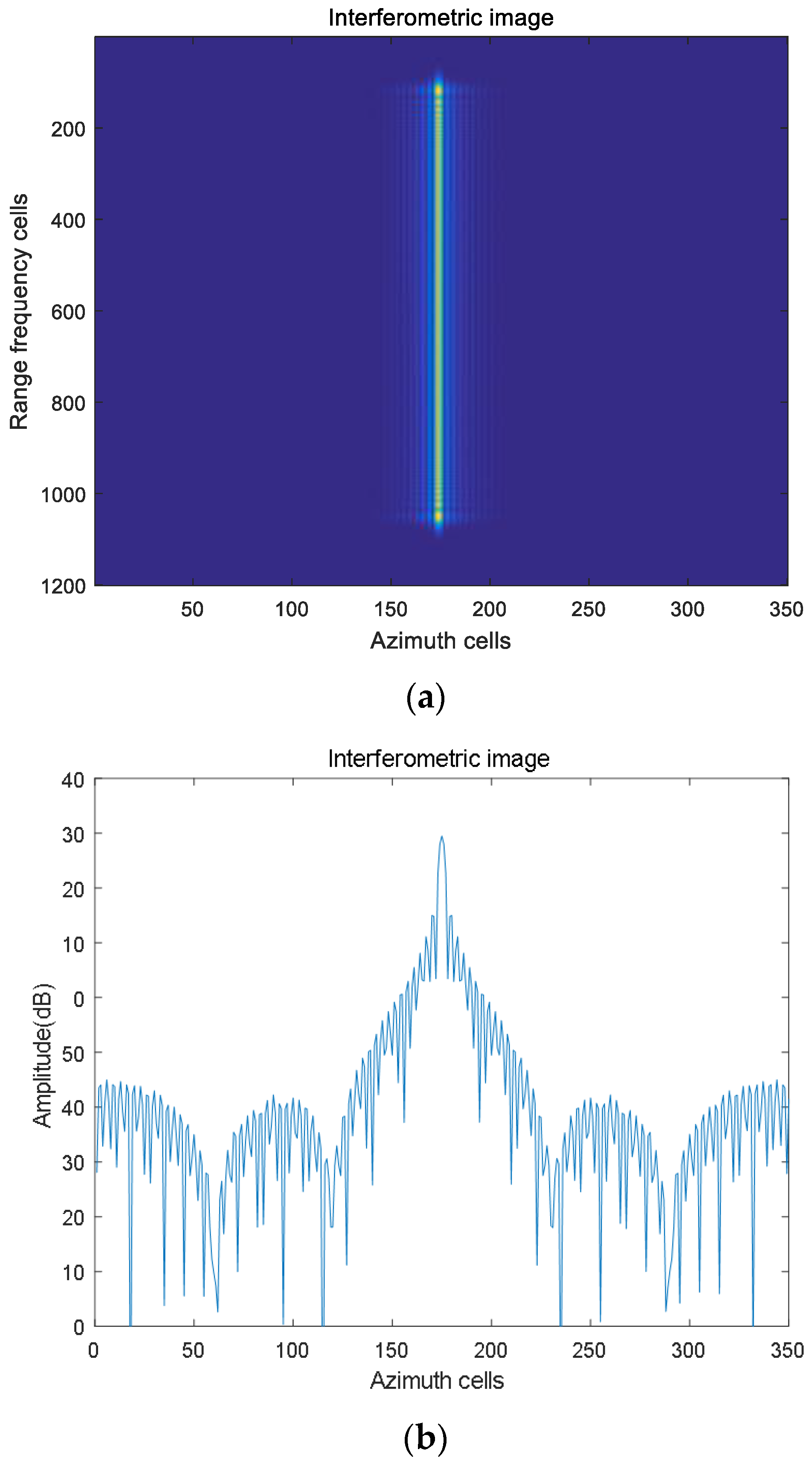


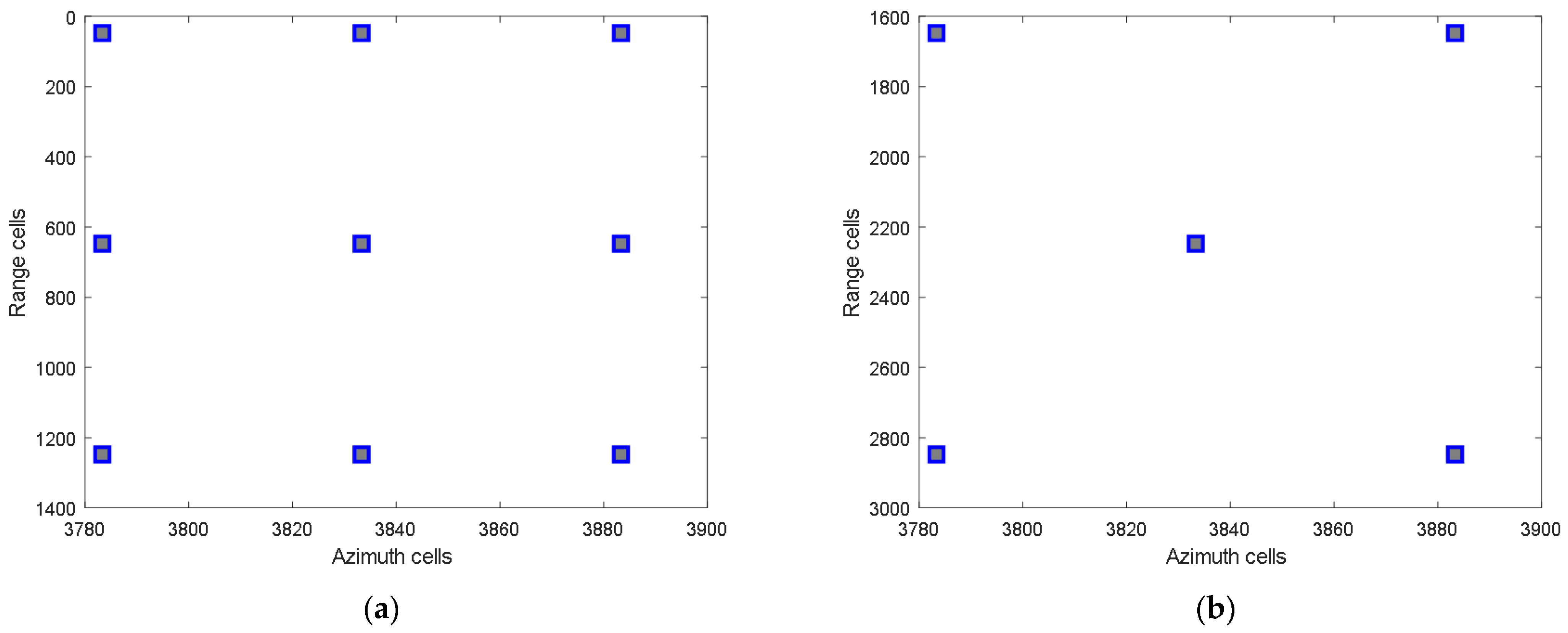

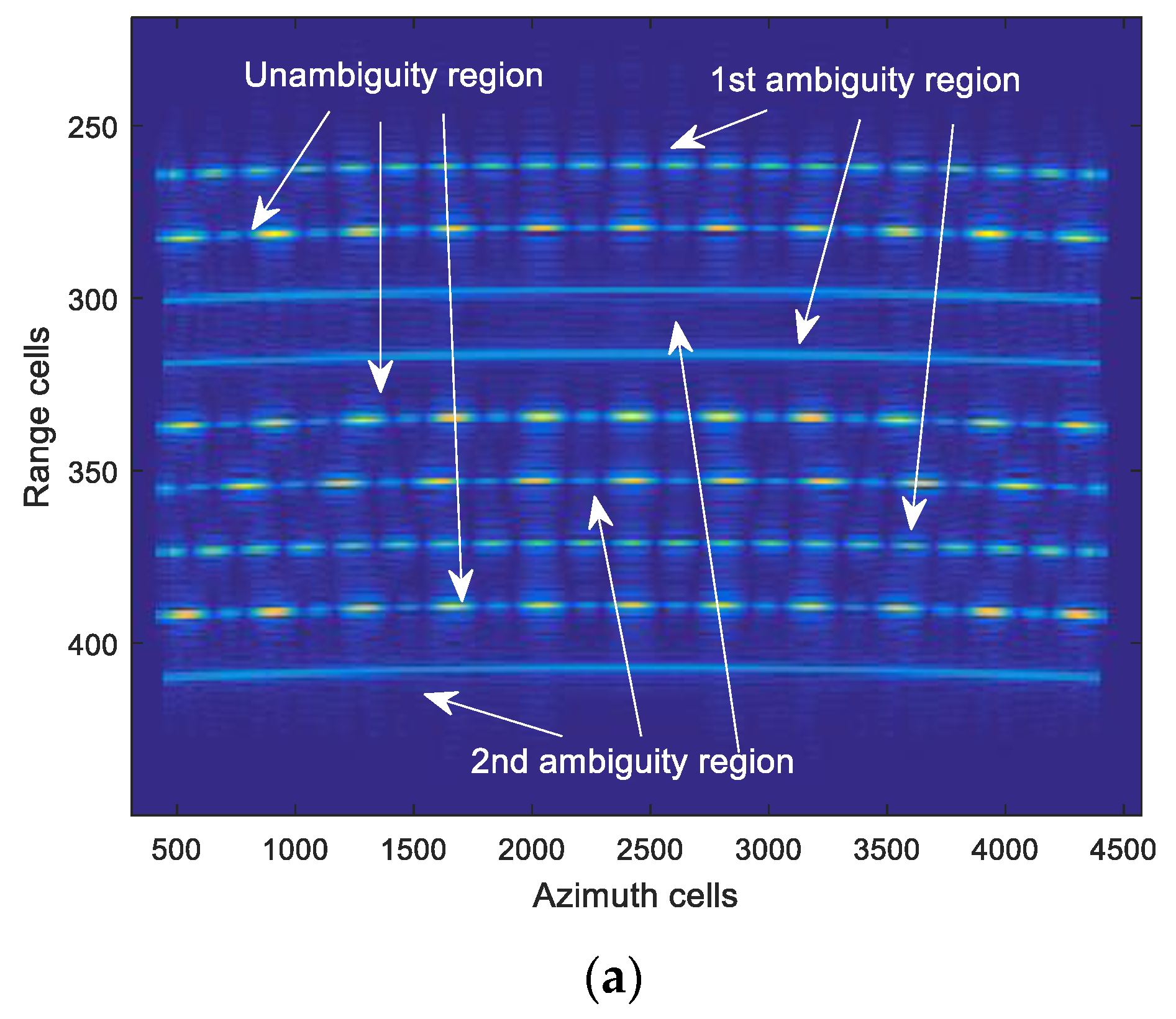
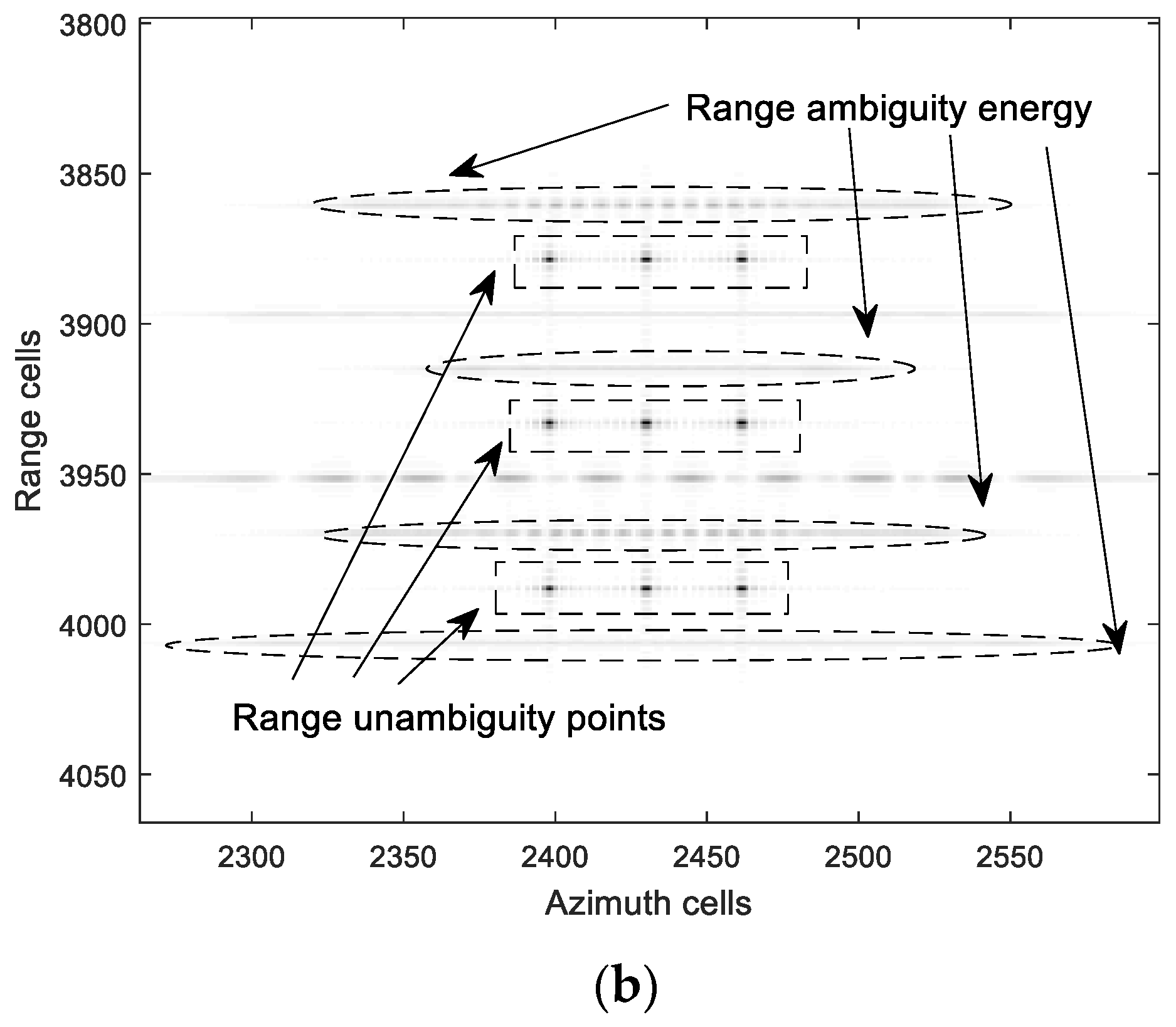

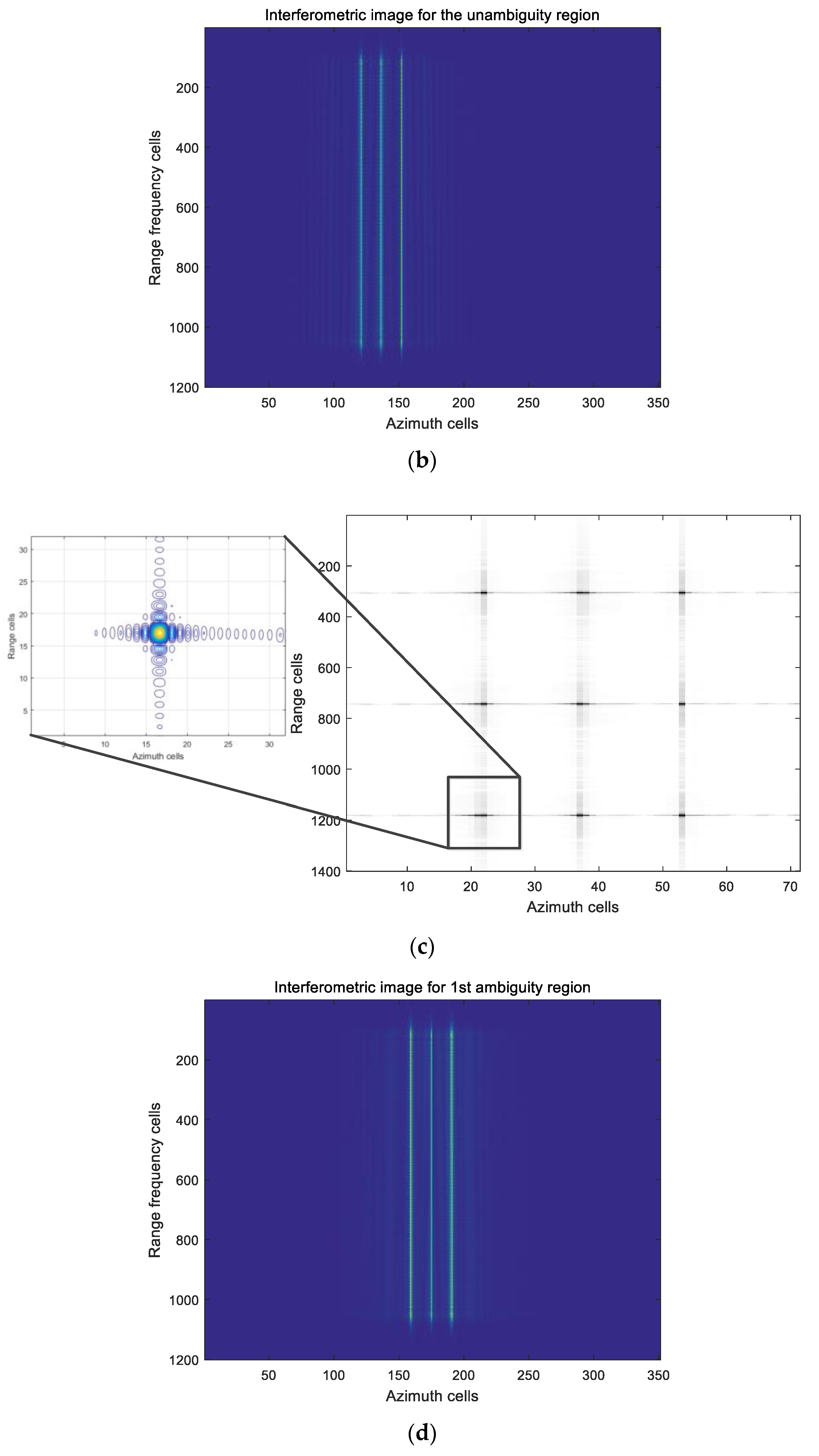
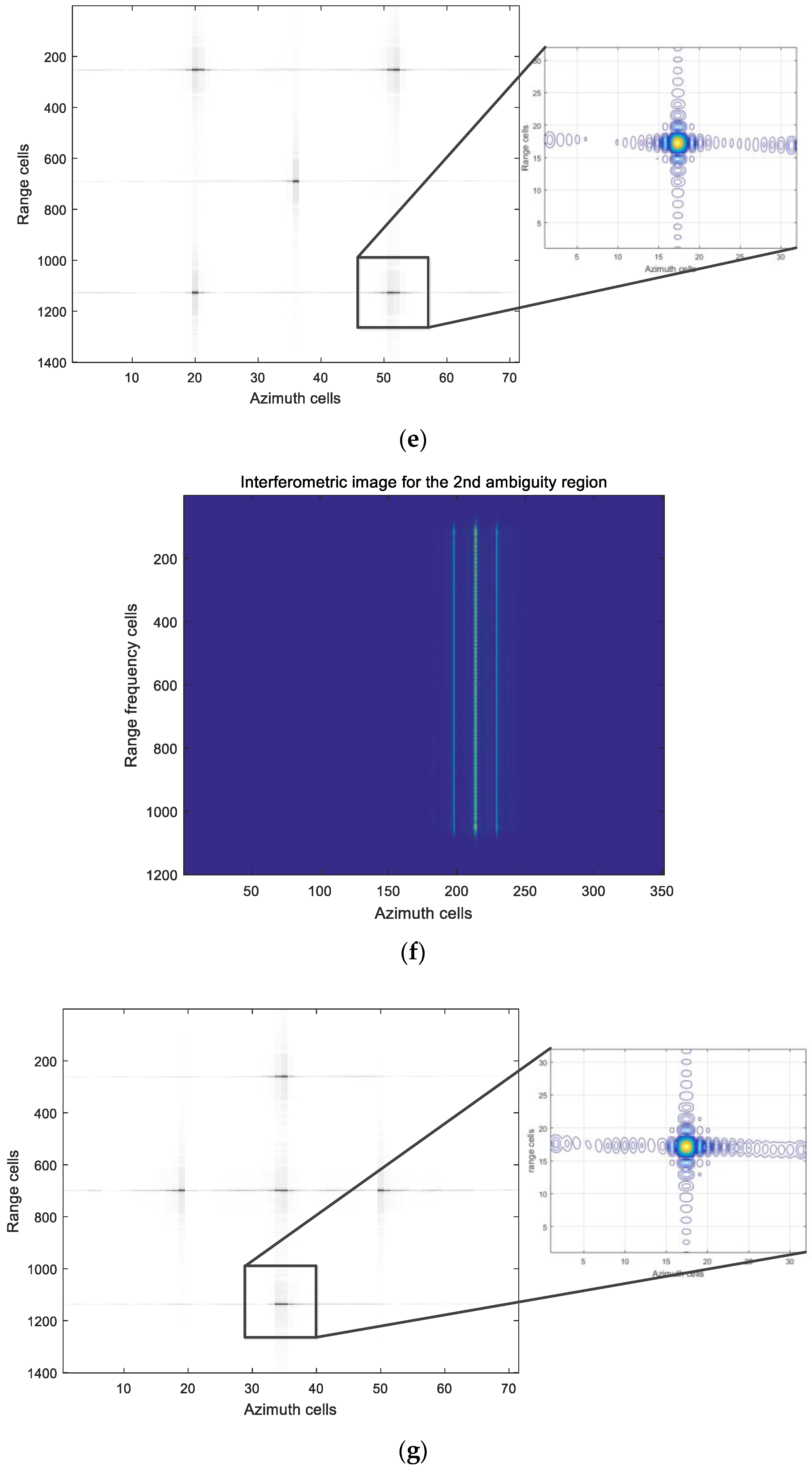
| Parameters | Values | |
|---|---|---|
| Number of transmitted elements | 2 | |
| Radar platform velocity | 7100 m/s | |
| Height of the radar platform | 800 km | |
| Carrier wavelength | 0.07 m | |
| Inter-element spacing | 0.14 m | |
| Bandwidth | 50 MHz | |
| Sampling frequency | 80 MHz | |
| Pulse repetition frequency | 4500 Hz | |
Publisher’s Note: MDPI stays neutral with regard to jurisdictional claims in published maps and institutional affiliations. |
© 2022 by the authors. Licensee MDPI, Basel, Switzerland. This article is an open access article distributed under the terms and conditions of the Creative Commons Attribution (CC BY) license (https://creativecommons.org/licenses/by/4.0/).
Share and Cite
Guo, Y.; Wang, Y.; Liao, G.; Li, J. Mitigating Range Ambiguity Method Based on DDMA for SAR Systems. Remote Sens. 2022, 14, 5485. https://doi.org/10.3390/rs14215485
Guo Y, Wang Y, Liao G, Li J. Mitigating Range Ambiguity Method Based on DDMA for SAR Systems. Remote Sensing. 2022; 14(21):5485. https://doi.org/10.3390/rs14215485
Chicago/Turabian StyleGuo, Yifan, Yingmin Wang, Guisheng Liao, and Jun Li. 2022. "Mitigating Range Ambiguity Method Based on DDMA for SAR Systems" Remote Sensing 14, no. 21: 5485. https://doi.org/10.3390/rs14215485
APA StyleGuo, Y., Wang, Y., Liao, G., & Li, J. (2022). Mitigating Range Ambiguity Method Based on DDMA for SAR Systems. Remote Sensing, 14(21), 5485. https://doi.org/10.3390/rs14215485








